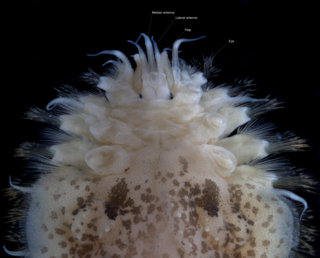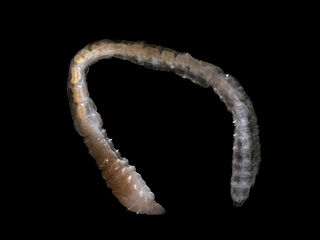
Polychaeta is a paraphyletic class of generally marine annelid worms, commonly called bristle worms or polychaetes. Each body segment has a pair of fleshy protrusions called parapodia that bear many bristles, called chaetae, which are made of chitin. More than 10,000 species are described in this class. Common representatives include the lugworm and the sandworm or clam worm Alitta.

A chaeta or cheta is a chitinous bristle or seta found in annelid worms,. Polychaete annelids, are named for their chaetae. In Polychaeta, chaetae are found as bundles on the parapodia, paired appendages on the side of the body. The chaetae are epidermal extracellular structures, and clearly visible in most polychaetes. They are probably the best studied structures in these animals. Segments bearing chaetae are called chaetigers.

The Clitellata are a class of annelid worms, characterized by having a clitellum - the 'collar' that forms a reproductive cocoon during part of their life cycles. The clitellates comprise around 8,000 species. Unlike the class of Polychaeta, they do not have parapodia and their heads are less developed.

The prostomium is the cephalized first body segment in an annelid worm's body at the anterior end. It is in front of the mouth, being usually a small shelf- or lip-like extension over the dorsal side of the mouth. The prostomium together with the peristomium, which includes the mouth and pharynx, make up the annelid head.

Canadia is a genus of extinct annelid worm present in Burgess Shale type Konservat-Lagerstätte. It is found in strata dating back to the Delamaran stage of the Middle Cambrian around 505 million years ago, during the time of the Cambrian explosion. It was about 3 centimeters in length. Charles Doolittle Walcott named Canadia in 1911 after Canada, the country from which its remains have been found. 28 specimens of Canadia are known from the Greater Phyllopod bed, where they comprise 0.05% of the community.
Teuthidodrilus samae, dubbed as the squidworm, is a species of acrocirrid marine annelid worms. It is free-swimming and can be found in the deep sea water column at depths of 2,039 to 2,912 m. It feeds on marine snow and can grow to about 9 cm (3.5 in) in length and 1 cm (0.39 in) in width. It is named for the ten squid-like appendages emerging from its head. It was discovered in 2007 in the benthopelagic zone of the Celebes Sea, near the Tawi-Tawi islands of the Philippines. It is the only species in the genus Teuthidodrilus.

Eunicida is an order of polychaete worms.

Phyllodocida is an order of polychaete worms in the subclass Aciculata. These worms are mostly marine, though some are found in brackish water. Most are active benthic creatures, moving over the surface or burrowing in sediments, or living in cracks and crevices in bedrock. A few construct tubes in which they live and some are pelagic, swimming through the water column. There are estimated to be more than 4,600 accepted species in the order.

Scolecida is an infraclass of polychaete worms. Scolecids are mostly unselective deposit feeders on marine detritus.
Haplosyllis spongicola, the sponge worm, is a species of polychaete worm in the family Syllidae. It was previously classified as Syllis spongicola and is part of a species complex of closely related species that are difficult to distinguish morphologically and where the demarcation between them is unclear. It is found in shallow temperate, subtropical and tropical seas worldwide, wherever its host sponges are found.

Chloeia is a genus of marine polychaete worms.
Parapionosyllis winnunga is a species belonging to the phylum Annelida, a group known as the segmented worms. Parapionosyllis winnunga is characterized by the shape of the blades of its compound chaetae, which have a long subdistal spine, in turn much longer than in other cogenerate species. Its species name is derived from the Aboriginal word winnunga, meaning "small".
Ophryotrocha craigsmithi is a species of polychaete worm. O. craigsmithi is named after Craig R. Smith. This species is similar to Palpiphitime lipovskyae and O. Platykephale, among others, in having branchial structures dorsally and ventrally. It differs from O. platykephale in the shape of its prostomium and parapodia. Palpiphitime lipovskyae has jaws of both P- and K-type, while no specimens of O. craigsmithi have been found with K-type jaws thus far. Ophryotrocha craigsmithi differs from P. lipovskyae genetically, but also by the presence of a prominent ventral chaetal lobe with a bulging simple chaeta in the former.
Nereis onychophora is a polychaete worm of the phylum Annelida. The type locality is in the Seram Sea, Indonesia.

Phyllodocidae is a family of polychaete worms. Worms in this family live on the seabed and may burrow under the sediment.

Lepidasthenia is a genus of marine Polychaete worms belonging to the family Polynoidae. Species of Lepidasthenia are found worldwide to depths of about 1200 m but are more common in shallower water.

Poecilochaetus serpens is a species of marine polychaete worm in the family Poecilochaetidae. It is a benthic worm that burrows into soft sediment.
Antipathipolyeunoa is a genus of marine annelids in the family Polynoidae. The genus contains a single species, Antipathipolyeunoa nuttingi, found in the Caribbean Sea at a depth of 91 metres.
Parahololepidella is a genus of marine annelids in the family Polynoidae. The genus contains a single species, Parahololepidella greeffi, This species is known from the east equatorial Atlantic Ocean and Cape Verde Islands at a maximum depth of 30m.
Uncopolynoe is a genus of marine polychaete worms belonging to the family Polynoidae, the scaleworms. Uncopolynoe contains a single species, Uncopolynoe corallicola which is known from the Red Sea at a depth of 1 m.















